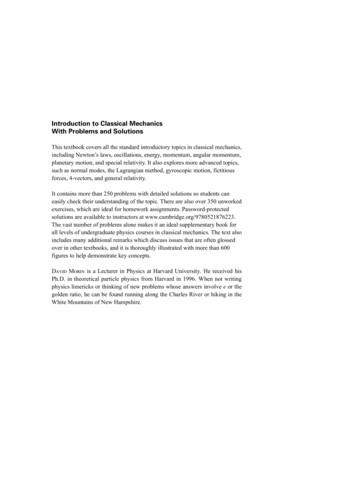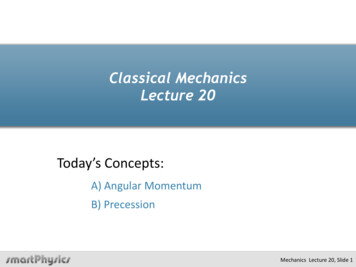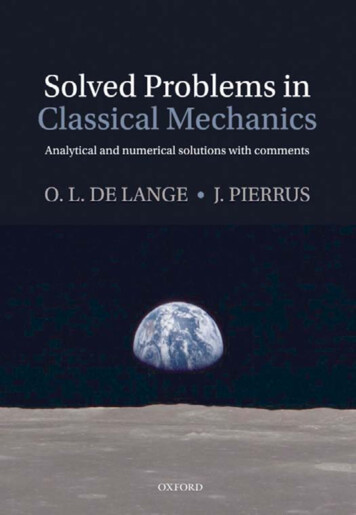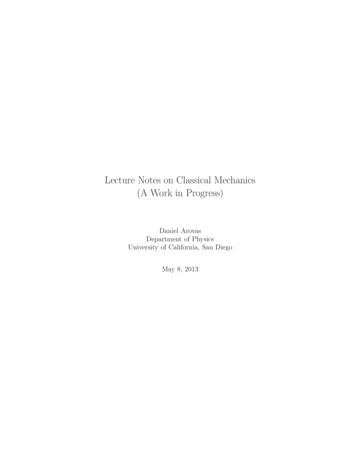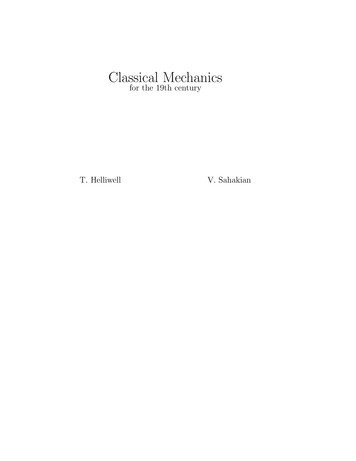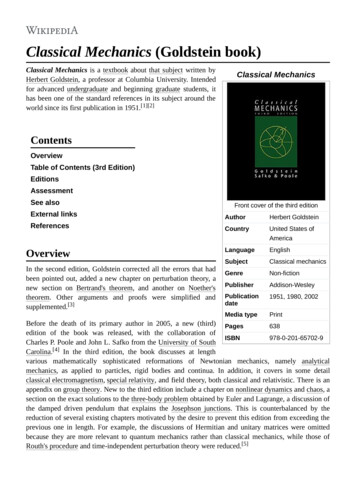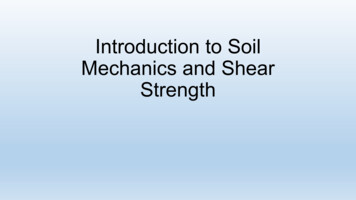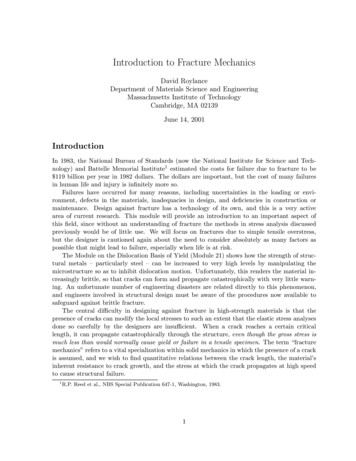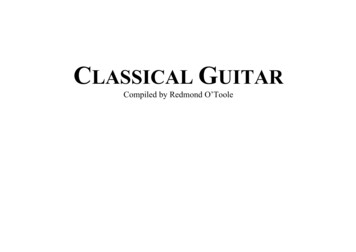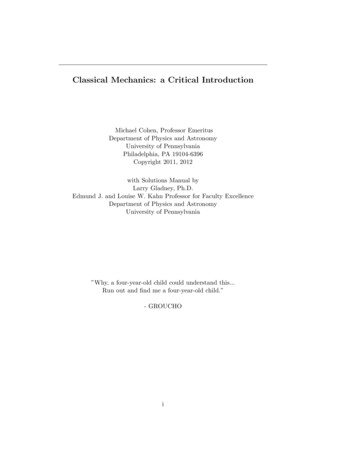
Transcription
Classical Mechanics: a Critical IntroductionMichael Cohen, Professor EmeritusDepartment of Physics and AstronomyUniversity of PennsylvaniaPhiladelphia, PA 19104-6396Copyright 2011, 2012with Solutions Manual byLarry Gladney, Ph.D.Edmund J. and Louise W. Kahn Professor for Faculty ExcellenceDepartment of Physics and AstronomyUniversity of Pennsylvania”Why, a four-year-old child could understand this.Run out and find me a four-year-old child.”- GROUCHOi
REVISED PREFACE (Jan. 2013)Anyone who has taught the “standard” Introductory Mechanics coursemore than a few times has most likely formed some fairly definite ideas regarding how the basic concepts should be presented, and will have identified(rightly or wrongly) the most common sources of difficulty for the student.An increasing number of people who think seriously about physics pedagogy have questioned the effectiveness of the traditional classroom with theProfessor lecturing and the students listening (perhaps). I take no positionregarding this question, but assume that a book can still have educationalvalue.The first draft of this book was composed many years ago and wasintended to serve either as a stand-alone text or as a supplementary “tutor”for the student. My motivation was the belief that most courses hurrythrough the basic concepts too quickly, and that a more leisurely discussionwould be helpful to many students. I let the project lapse when I found thatpublishers appeared to be interested mainly in massive textbooks coveringall of first-year physics.Now that it is possible to make this material available on the Internetto students at the University of Pennsylvania and elsewhere, I have revivedand reworked the project and hope the resulting document may be usefulto some readers. I owe special thanks to Professor Larry Gladney, whohas translated the text from its antiquated format into modern digital formand is also preparing a manual of solutions to the end-of-chapter problems.Professor Gladney is the author of many of these problems. The manualwill be on the Internet, but the serious student should construct his/her ownsolutions before reading Professor Gladney’s discussion. Conversations withmy colleague David Balamuth have been helpful, but I cannot find anyoneexcept myself to blame for errors or defects. An enlightening discussion withProfessor Paul Soven disabused me of the misconception that Newton’s FirstLaw is just a special case of the Second Law.The Creative Commons copyright permits anyone to download and reproduce all or part of this text, with clear acknowledgment of the source.Neither the text, nor any part of it, may be sold. If you distribute all orpart of this text together with additional material from other sources, pleaseidentify the sources of all materials. Corrections, comments, criticisms, additional problems will be most welcome. Thanks.Michael Cohen, Dept. of Physics and Astronomy, Univ. of Pa.,Phila, PA 19104-6396email: micohen@physics.upenn.eduii
0.1. INTRODUCTION0.1IntroductionClassical mechanics deals with the question of how an object moves when itis subjected to various forces, and also with the question of what forces acton an object which is not moving.The word “classical” indicates that we are not discussing phenomena onthe atomic scale and we are not discussing situations in which an objectmoves with a velocity which is an appreciable fraction of the velocity oflight. The description of atomic phenomena requires quantum mechanics,and the description of phenomena at very high velocities requires Einstein’sTheory of Relativity. Both quantum mechanics and relativity were inventedin the twentieth century; the laws of classical mechanics were stated by SirIsaac Newton in 1687[New02].The laws of classical mechanics enable us to calculate the trajectoriesof baseballs and bullets, space vehicles (during the time when the rocketengines are burning, and subsequently), and planets as they move aroundthe sun. Using these laws we can predict the position-versus-time relationfor a cylinder rolling down an inclined plane or for an oscillating pendulum,and can calculate the tension in the wire when a picture is hanging on awall.The practical importance of the subject hardly requires demonstrationin a world which contains automobiles, buildings, airplanes, bridges, andballistic missiles. Even for the person who does not have any professionalreason to be interested in any of these mundane things, there is a compellingintellectual reason to study classical mechanics: this is the example parexcellence of a theory which explains an incredible multitude of phenomenaon the basis of a minimal number of simple principles. Anyone who seriouslystudies mechanics, even at an elementary level, will find the experience atrue intellectual adventure and will acquire a permanent respect for thesubtleties involved in applying “simple” concepts to the analysis of “simple”systems.I wish to distinguish very clearly between “subtlety” and “trickery”.There is no trickery in this subject. The subtlety consists in the necessity ofusing concepts and terminology quite precisely. Vagueness in one’s thinking and slight conceptual imprecisions which would be acceptable in everyday discourse will lead almost invariably to incorrect solutions in mechanicsproblems.In most introductory physics courses approximately one semester (usually a bit less than one semester) is devoted to mechanics. The instructorand students usually labor under the pressure of being required to “cover” aiii
0.1. INTRODUCTIONcertain amount of material. It is difficult, or even impossible, to “cover” thestandard topics in mechanics in one semester without passing too hastilyover a number of fundamental concepts which form the basis for everythingwhich follows.Perhaps the most common area of confusion has to do with the listing ofthe forces which act on a given object. Most people require a considerableamount of practice before they can make a correct list. One must learnto distinguish between the forces acting on a thing and the forces which itexerts on other things, and one must learn the difference between real forces(pushes and pulls caused by the action of one material object on another)and demons like “centrifugal force” (the tendency of an object moving in acircle to slip outwards) which must be expunged from the list of forces.An impatient reader may be annoyed by amount of space devoted todiscussion of “obvious” concepts such as “force”, “tension”, and “friction”.The reader (unlike the student who is trapped in a boring lecture) is, ofcourse, free to turn to the next page. I believe, however, that life is longenough to permit careful consideration of fundamental concepts and thattime thus spent is not wasted.With a few additions (some discussion of waves for example) this bookcan serve as a self-contained text, but I imagine that most readers woulduse it as a supplementary text or study guide in a course which uses anothertextbook. It can also serve as a text for an online course.Each chapter includes a number of Examples, which are problems relating to the material in the chapter, together with solutions and relevantdiscussion. None of these Examples is a “trick” problem, but some containfeatures which will challenge at least some of the readers. I strongly recommend that the reader write out her/his own solution to the Example beforereading the solution in the text.Some introductory Mechanics courses are advertised as not requiring anyknowledge of calculus, but calculus usually sneaks in even if anonymously(e.g. in the derivation of the acceleration of a particle moving in a circleor in the definition of work and the derivation of the relation between workand kinetic energy).Since Mechanics provides good illustrations of the physical meaning ofthe “derivative” and the “integral”, we introduce and explain these mathematical notions in the appropriate context. At no extra charge the readerwho is not familiar with vector notation and vector algebra will find a discussion of those topics in Appendix A.iv
Contents0.1Introduction . . . . . . . . . . . . . . . . . . . . . . . . . . . .iii1 KINEMATICS: THE MATHEMATICAL DESCRIPTIONOF MOTION1.1 Motion in One Dimension . . . . . . . . . . . . . . . . . . . .1.2 Acceleration . . . . . . . . . . . . . . . . . . . . . . . . . . . .1.3 Motion With Constant Acceleration . . . . . . . . . . . . . .1.4 Motion in Two and Three Dimensions . . . . . . . . . . . . .1.4.1 Circular Motion: Geometrical Method . . . . . . . . .1.4.2 Circular Motion: Analytic Method . . . . . . . . . . .1.5 Motion Of A Freely Falling Body . . . . . . . . . . . . . . . .1.6 Kinematics Problems . . . . . . . . . . . . . . . . . . . . . . .1.6.1 One-Dimensional Motion . . . . . . . . . . . . . . . .1.6.2 Two and Three Dimensional Motion . . . . . . . . . .1167101214152020212 NEWTON’S FIRST AND THIRD LAWS: STATICSPARTICLES2.1 Newton’s First Law; Forces . . . . . . . . . . . . . . . . .2.2 Inertial Frames . . . . . . . . . . . . . . . . . . . . . . . .2.3 Quantitative Definition of Force; Statics of Particles . . .2.4 Examples of Static Equilibrium of Particles . . . . . . . .2.5 Newton’s Third Law . . . . . . . . . . . . . . . . . . . . .2.6 Ropes and Strings; the Meaning of “Tension” . . . . . . .2.7 Friction . . . . . . . . . . . . . . . . . . . . . . . . . . . .2.8 Kinetic Friction . . . . . . . . . . . . . . . . . . . . . . . .2.9 Newton’s First Law of Motion Problems . . . . . . . . . .25252830323843526367OF.3 NEWTON’S SECOND LAW; DYNAMICS OF PARTICLES 693.1 Dynamics Of Particles . . . . . . . . . . . . . . . . . . . . . . 693.2 Motion of Planets and Satellites; Newton’s Law of Gravitation 94v
CONTENTS3.3CONTENTSNewton’s 2nd Law of Motion Problems . . . . . . . . . . . . . 1014 CONSERVATION AND NON-CONSERVATION OFMENTUM4.1 PRINCIPLE OF CONSERVATION OF MOMENTUM4.2 Center of Mass . . . . . . . . . . . . . . . . . . . . . . .4.3 Time-Averaged Force . . . . . . . . . . . . . . . . . . . .4.4 Momentum Problems . . . . . . . . . . . . . . . . . . . .MO105. . . 105. . . 111. . . 115. . . 1225 WORK AND ENERGY1255.1 Definition of Work . . . . . . . . . . . . . . . . . . . . . . . . 1255.2 The Work-Energy Theorem . . . . . . . . . . . . . . . . . . . 1275.3 Potential Energy . . . . . . . . . . . . . . . . . . . . . . . . . 1365.4 More General Significance of Energy (Qualitative Discussion) 1425.5 Elastic and Inelastic Collisions . . . . . . . . . . . . . . . . . 1435.5.1 Relative Velocity in One-Dimensional Elastic Collisions 1475.5.2 Two Dimensional Elastic Collisions . . . . . . . . . . . 1475.6 Power and Units of Work . . . . . . . . . . . . . . . . . . . . 1495.7 Work and Conservation of Energy Problems . . . . . . . . . . 1516 SIMPLE HARMONIC MOTION1556.1 Hooke’s Law and the Differential Equation for Simple Harmonic Motion . . . . . . . . . . . . . . . . . . . . . . . . . . . 1556.2 Solution by Calculus . . . . . . . . . . . . . . . . . . . . . . . 1576.3 Geometrical Solution of the Differential Equation of SimpleHarmonic Motion; the Circle of Reference . . . . . . . . . . . 1636.4 Energy Considerations in Simple Harmonic Motion . . . . . . 1656.5 Small Oscillations of a Pendulum . . . . . . . . . . . . . . . . 1666.6 Simple Harmonic Oscillation Problems . . . . . . . . . . . . . 1727 Static Equilibrium of Simple Rigid Bodies1757.1 Definition of Torque . . . . . . . . . . . . . . . . . . . . . . . 1767.2 Static Equilibrium of Extended Bodies . . . . . . . . . . . . . 1777.3 Static Equilibrium Problems . . . . . . . . . . . . . . . . . . . 1928 Rotational Motion, Angular MomentumRigid Bodies8.1 Angular Momentum and Central Forces .8.2 Systems Of More Than One Particle . . .8.3 Simple Rotational Motion Examples . . .viand Dynamics of195. . . . . . . . . . . 196. . . . . . . . . . . 199. . . . . . . . . . . 203
CONTENTS8.48.58.6CONTENTSRolling Motion . . . . . . . . . . . . . . . . . . . . . . . . . . 211Work-Energy for Rigid Body Dynamics . . . . . . . . . . . . 222Rotational Motion Problems . . . . . . . . . . . . . . . . . . . 2319 REMARKS ON NEWTON’S LAW OF UNIVERSAL GRAVITATION - contributed by Larry Gladney2359.1 Determination of g . . . . . . . . . . . . . . . . . . . . . . . . 2369.2 Kepler’s First Law of Planetary Motion . . . . . . . . . . . . 2399.3 Gravitational Orbit Problems . . . . . . . . . . . . . . . . . . 24610 APPENDICES247A Appendix A249A.1 Vectors . . . . . . . . . . . . . . . . . . . . . . . . . . . . . . 249A.1.1 Definitions and Proofs . . . . . . . . . . . . . . . . . . 250B Appendix B261B.1 Useful Theorems about Energy, Angular Momentum, & Moment of Inertia . . . . . . . . . . . . . . . . . . . . . . . . . . 261C Appendix C265C.1 Proof That Force Is A Vector . . . . . . . . . . . . . . . . . . 265D Appendix D269D.1 Equivalence of Acceleration of Axes and a Fictional Gravitational Force . . . . . . . . . . . . . . . . . . . . . . . . . . . . 269E Appendix E271E.1 Developing Your Problem-Solving Skills: Helpful(?) Suggestions . . . . . . . . . . . . . . . . . . . . . . . . . . . . . . . . 271PREFACE TO SOLUTIONS MANUAL2731 KINEMATICS2751.1 Kinematics Problems Solutions . . . . . . . . . . . . . . . . . 2751.1.1 One-Dimensional Motion . . . . . . . . . . . . . . . . 2751.1.2 Two and Three Dimensional Motion . . . . . . . . . . 2802 NEWTON’S FIRST AND THIRD LAWS2832.1 Newton’s First and Third Laws of Motion Solutions . . . . . 283vii
CONTENTSCONTENTS3 NEWTON’S SECOND LAW2893.1 Newton’s Second Law of Motion Problem Solutions . . . . . . 2894 MOMENTUM3034.1 Momentum Problem Solutions . . . . . . . . . . . . . . . . . 3035 WORK AND ENERGY3115.1 Work and Conservation of Energy Problem Solutions . . . . . 3116 Simple Harmonic Motion3216.1 Simple Harmonic Motion Problem Solutions . . . . . . . . . . 3217 Static Equilibrium of Simple Rigid Bodies3257.1 Static Equilibrium Problem Solutions . . . . . . . . . . . . . 3258 Rotational Motion, Angular Momentum and Dynamics ofRigid Bodies3338.1 Rotational Motion Problem Solutions . . . . . . . . . . . . . 3339 Remarks on Gravitation3499.1 Remarks on Gravity Problem Solutions . . . . . . . . . . . . 349viii
Chapter 1KINEMATICS: THEMATHEMATICALDESCRIPTION OFMOTIONKinematics is simply the mathematical description of motion, and makesno reference to the forces which cause the motion. Thus, kinematics is notreally part of physics but provides us with the mathematical frameworkwithin which the laws of physics can be stated in a precise way.1.1Motion in One DimensionLet us think about a material object (a “particle”) which is constrained tomove along a given straight line (e.g. an automobile moving along a straighthighway). If we take some point on the line as an origin, the position of theparticle at any instant can be specified by a number x which gives thedistance from the origin to the particle. Positive values of x are assignedto points on one side of the origin, and negative values of x are assigned topoints on the other side of the origin, so that each value of x corresponds toa unique point. Which direction is taken as positive and which as negativeis purely a matter of convention. The numerical value of x clearly dependson the unit of length we are using (e.g. feet, meters, or miles). Unless theparticle is at rest, x will vary with time. The value of x at time t is denotedby x(t).1
1.1. MOTION IN ONE DIMENSIONThe average velocity of a particle during the time interval from t to t0is defined asx(t0 ) x(t)vavg (1.1)t0 ti.e. the change in position divided by the change in time. If we draw a graphof x versus t (for example, Fig.1.1) we see that [x(t0 ) x(t)]/[t0 t] is justthe slope of the dashed straight line connecting the points which representthe positions of the particle at times t0 and t.Figure 1.1: An example graph of position versus time.A more important and more subtle notion is that of instantaneousvelocity (which is what your car’s speedometer shows). If we hold t fixedand let t0 be closer and closer to t, the quotient [x(t0 ) x(t)]/[t0 t] willapproach a definite limiting value (provided that the graph of x versus t issufficiently smooth) which is just the slope of the tangent to the x versus tcurve at the point (t, x(t)). This limiting value, which may be thought of asthe average velocity over an infinitesimal time interval which includes thetime t, is called the “ the instantaneous velocity at time t” or, more briefly,“the velocity at time t”. We writex(t0 ) x(t).t tt0 tv(t) lim0(1.2)This equation is familiar to anyone who has studied differential calculus;the right side is called “the derivative of x with respect to t” and frequentlydenoted by dx/dt. Thus v(t) dx/dt.If x(t) is given in the form of an explicit formula, we can calculatev(t) either directly from equation 1.2 or by using the rules for calculatingderivatives which are taught in all calculus courses (these rules, for exampled/dt (tn ) n tn 1 , merely summarize the results of evaluating the rightside of (1.2) for various functional forms of x(t)). A useful exercise is todraw a qualitatively correct graph of v(t) when x(t) is given in the form of2
1.1. MOTION IN ONE DIMENSIONa graph, rather than as a formula. Suppose, for example, that the graphof x(t) is Fig.1.2. We draw a graph of v(t) by estimating the slope of thev (ft/sec)2001234t (sec.)Figure 1.2: Another example of aposition versus time graph.Figure 1.3: The correspondinggraph of velocity versus time.x-versus-t graph at each point. We see that the slope is positive at t 0(with a numerical value of about 200 ft/sec, though we are not interestedin very accurate numbers here) and continues positive but with decreasingvalues until t 1. The slope is zero between t 1 and t 2, and thenbecomes negative, etc. (If positive v means that the object is going forward,then negative v means that the object is going backward.) An approximategraph of v(t) is given by Fig.1.3.If we are given v(t), either as a formula or a graph, we can calculate x(t).The mathematical process of finding the function x(t) when its slope v(t) isgiven at all points is called “integration”. For example, if v(t) 9t3 , thenx(t) (9/4)t4 c where c is any constant (the proof is simply to calculatedx/dt and verify that we obtain the desired v(t)). The appearance of thearbitrary constant c in x(t) is not surprising, since knowledge of the velocityat all times is not quite sufficient to fully determine the position at all times.We must also know where the particle started, i.e. the value of x when t 0.If x(t) (9/4)t4 c, then x(0) c.Suppose we are given the graph of v(t), for example Fig.1.4. Let usconsider the shaded rectangle whose height is v(t) and whose wdith is ,where is a very small time interval.3
1.1. MOTION IN ONE DIMENSIONFigure 1.4: The shaded area is the displacement during t t .The area of this rectangle is v(t) , which is equal to the displacement(i.e. the change in x) of the particle during the time interval from t tot . (Strictly speaking, the previous statement is not exactly true unlessv(t) is constant during the time interval from t to t , but if is smallenough the variation of v during this interval may be neglected.) If t1 andt2 are any two times, and if we divide the interval between them into manysmall intervals, the displacement during any sub-interval is approximatelyequal to the area of the corresponding rectangle in Fig.1.5. Thus the netdisplacement x(t2 ) x(t1 ) is approximately equal to the sum of the areas ofthe rectangles. If the sub-intervals are made smaller and smaller, the errorin this approximation becomes negligible, and thus we see that the areaunder the portion of the v versus t curve between time t1 and t2 is equal tothe displacement x(t2 ) x(t1 ) experienced by the particle during that timeinterval.Figure 1.5: The shaded area is the displacement during t1 t2 .The above statement is true even if v becomes negative, provided wedefine the area as negative in regions where v is negative. In the notation4
1.1. MOTION IN ONE DIMENSIONof integral calculus we writeZt2x(t2 ) x(t1 ) v(t) dt(1.3)t1The right side of eqn.(1.3) is called the “integral of v(t) with respect to tfrom t1 to t2 ” and is defined mathematically as the limit of the sum of theareas of the rectangles in Fig.1.5 as the width of the individual rectanglestends to zero.v (ft/sec)502048121618t (sec.)Figure 1.6: Plot of velocity versus time for an automobile.Example 1.1 : Calculating distance and average velocityFig.1.6 shows the velocity of an auto as a function of time. Calculate thedistance of the auto from its starting point at t 6, 12, 16 and 18 sec.Calculate the average velocity during the period from t 4 sec to t 15sec and during the period from t 0 to t 18 sec.Solution: Calculating areas: x(6) 40 40 800 ; x(12) 40 80 140 2600 ; x(16) 260 4(50 16.67)/2 393.30 ; x(18) 260 150 4100 .x(15) x(4) 332.50 ; avg. vel. from t 4 to t 15 30.23 ft/sec; avg. vel.from t 0 to t 18 22.78 ft/sec [Note: After students have learned moreformulas many will use formulas rather than simple calculation of areas andget this wrong.]5
1.2. ACCELERATIONExample 1.2 :A woman is driving between two toll booths 60 miles apart. She drives thefirst 30 miles at a speed of 40 mph. At what (constant) speed should shedrive the remaining miles so that her average speed between the toll boothswill be 50 mph?Solution: If T is total time, 50 60/T , so T 1.2 hrs. Time for first30 mi 30/40 0.75 hr. Therefore, the time for the remaining 30 mi 1.2 .75 .45 hr. The speed during the second 30 miles must be 30/.45 66.67 mi/hr.1.2AccelerationAcceleration is defined as the rate of change of velocity . The averageacceleration during the interval from t to t0 is defined asaavg v(t0 ) v(t)t0 t(1.4)where v(t0 ) and v(t) are the instantaneous values of the velocity at times t0and t. The instantaneous acceleration is defined as the average accelerationover an infinitesimal time interval, i.e.v(t0 ) v(t)t tt0 ta(t) lim0(1.5)Since v(t) dx/dt, we can write (in the notation of calculus) a(t) d2 x/dt2 .We stress that this is simply shorthand for a(t) d/dt [dx/dt].Comparing eqns.(1.5) and (1.2) we see that the relation between a(t)and v(t) is the same as the relation between v(t) and x(t). It follows thatif v(t) is given as a graph, the slope of the graph is a(t). If a(t) is givenas a graph then we should also expect that the area under the portion ofthe graph between time t1 and time t2 is equal to the change in velocityv(t2 ) v(t1 ). The analogue of eqn.(1.3) isZ t2v(t2 ) v(t1 ) a(t) dt(1.6)t16
1.3. MOTION WITH CONSTANT ACCELERATIONExample 1.3 : Instantaneous AccelerationDraw a graph of the instantaneous acceleration a(t) if v(t) is given byFig.1.6.1.3Motion With Constant AccelerationAll of the preceding discussion is entirely general and applies to any onedimensional motion. An important special case is motion in which the acceleration is constant in time. We shall shortly see that this case occurswhenever the forces are the same at all times. The graph of accelerationversus time is simple (Fig.1.7). The area under the portion of this graphFigure 1.7: Plot of constant acceleration.between time zero and time t is just a · t. Therefore v(t) v(0) a t. Tomake contact with the notation commonly used we write v instead of v(t)and v0 instead of v(0). Thus,v v0 at(1.7)The graph of v versus t (Fig.1.8) is a straight line with slope a. We can getan explicit formula for x(t) by inserting this expression into eqn.(1.3) andperforming the integration or, without calculus, by calculating the shadedarea under the line of Fig.1.8 between t 0 and t. Geometrically (Fig.1.9),the area under Fig.1.8 between t 0 and t is the width t multiplied by theheight at the midpoint which is 1/2 (v0 v0 at). Thus we find x(t) x0 1/2 (2v0 t at2 ). Finally,1x x0 (v v0 )t27(1.8)
1.3. MOTION WITH CONSTANT ACCELERATIONFigure 1.8: Plot of velocity versus time for constant acceleration.Figure 1.9: Area under the curve of v versus t.If we want to use calculus (i.e. eqn.(1.3)) we writeZx(t) x(0) 0t1(v0 at0 ) dt0 v0 t at22(1.9)(note that we have renamed the “dummy” integration variable t0 in orderto avoid confusion with t which is the upper limit of the integral).Comparing eqn.(1.8) with the definition (eqn.(1.1)) of average velocitywe see that the average velocity during any time interval is half the sum ofthe initial and final velocities. Except for special cases, this is true only foruniformly accelerated motion.Sometimes we are interested in knowing the velocity as a function of theposition x rather than as a function of the time t. If we solve eqn.(1.7) fort, i.e. t (v v0 )/a and substitute into eqn.(1.8) we obtainv 2 v02 2a(x x0 )(1.10)We collect here the mathematical formulas derived above, all of which8
1.3. MOTION WITH CONSTANT ACCELERATIONare applicable only to motion with constant acceleration.v v0 at1x x0 (v v0 )t21x x0 v0 t at22v 2 v02 2a(x x0 )(1.11a)(1.11b)(1.11c)(1.11d)There is often more than one way to solve a problem, but not all waysare equally efficient. Depending on what information is given and whatquestion is asked, one of the above formulas usually leads most directly tothe answer.Example 1.4 : A constant acceleration problemA car decelerates (with constant deceleration) from 60 mi/hr to rest in adistance of 500 ft. [Note: 60 mph 88 ftsec]1. Calculate the acceleration.2. How long did it take?3. How far did the car travel between the instant when the brake wasfirst applied and the instant when the speed was 30 mph?4. If the car were going at 90 mph when the brakes were applied, butthe deceleration were the same as previously, how would the stoppingdistance and the stopping time change?Solution: We will use the symbols 88 ft/s v0 , 500 ft D.1. 0 v02 2aD a 7.74 ft/s22. T stopping time, D 1/2 v0 T T 11.36 s (could also useeqn.( 1.11a))3. D0 answer to (3), i.e.(1/2 v0 )2 v02 2aD0thusD0D v2where a 02D3 D0 375 ft49
1.4. MOTION IN TWO AND THREE DIMENSIONS4. D00 answer to (4). From (d) D00 /D (90/60)2 D00 1125 ft.From (a) the stopping time is (3/2)11.36 17.04 sec.Example 1.5 : Another example of constant accelerationA drag racer accelerates her car with constant acceleration on a straightdrag strip. She passes a radar gun (#1) which measures her instantaneousspeed at 60 ft/s and subsequently passes a second radar gun (#2) whichmeasures her instantaneous speed as 150 ft/s.1. What is her speed at the midpoint (in time) of the interval betweenthe two measurements?2. What is her speed when she is equidistant from the two radar guns?3. If the distance between the two radar guns is 500 ft, how far from gun#1 is the starting point?Solution: Symbols: v1 60 v2 150 T time interval D spaceinterval.1. a (v2 v1 )/T . At T /2 v v1 aT /2 (v1 v2 )/2 105 ft/s.2. v3 speed at D/2 a (v22 v12 )/2D. v32 v12 2aD/2 (v12 v22 )/2 v3 114.24 ft/s3. D0 dist. from starting point to #1. v12 2aD0 D0 v12 D/(v22 v12 ) 95.2 ft.1.4Motion in Two and Three DimensionsThe motion of a particle is not necessarily confined to a straight line (consider, for example, a fly ball or a satellite in orbit around the earth), andin general three Cartesian coordinates, usually referred to as x(t), y(t), z(t)are required to specify the position of the particle at time t. In almost allof the situations which we shall discuss, the motion is confined to a plane;10
1.4. MOTION IN TWO AND THREE DIMENSIONSif we take two of our axes (e.g. the x and y axes) in the plane, then onlytwo coordinates are required to specify the position.Extensions of the notion of velocity and acceleration to three dimensions is straightforward. If the coordinates of the particle at time t are(x(t), y(t), z(t)) and at t0 are (x(t0 ), y(t0 ), z(t0 )), then we define the average x-velocity during the time interval t t0 by the equation vx,av [x(t0 ) x(t)]/[t0 t]. Similar equations define vy, av and vz, av . The instantaneous x-velocity, y-velocity, and z-velocity are defined exactly as in thecase of one-dimensional motion, i.e.x(t0 ) x(t)dx 0t tt tdtvx (t) lim0(1.12)and so on. Similarly, we define ax,avg [vx (t0 ) vx (t)]/[t0 t] with similardefinitions for ay, avg and az, avg . The instantaneous x-acceleration isvx (t0 ) vx (t)d2 x t tt0 tdt2ax (t) lim0(1.13)with similar definitions of ay (t) and az (t).All of the above seems somewhat heavy-handed and it is almost obviousthat by introducing more elegant notation we could replace three equationsby a single equation. The more elegant notation, which is called vectornotation, has an even more important advantage: it enables us to state thelaws of physics in a form which is obviously independent of the orientation ofthe particular axes which we have arbitrarily chosen. The reader who is notfamiliar with vector notation and/or with the addition and subtraction ofvectors, should read the relevant part of Appendix A. The sections definingand explaining the dot product and cross product of two vectors are notrelevant at this point and may be omitted.We introduce the symbol r as shorthand for the number triplet (x, y, z)formed by the three coordinates of a particle. We call r the position vectorof the particle and we call x, y and z the components of the positionvector with respect to the chosen set of axes. In printed text a vector isusually represented by a boldfaced letter and in handwritten or typed texta vector is usually represented by a letter with a horizontal arrow over it.1The velocity and acceleration vectors are defined as r(t0 ) r(t)d r 0t tt tdt v (t) lim01(1.14)Since the first version of this text was in typed for
Classical mechanics deals with the question of how an object moves when it is subjected to various forces, and also with the question of what forces act . problems. In most introductory
